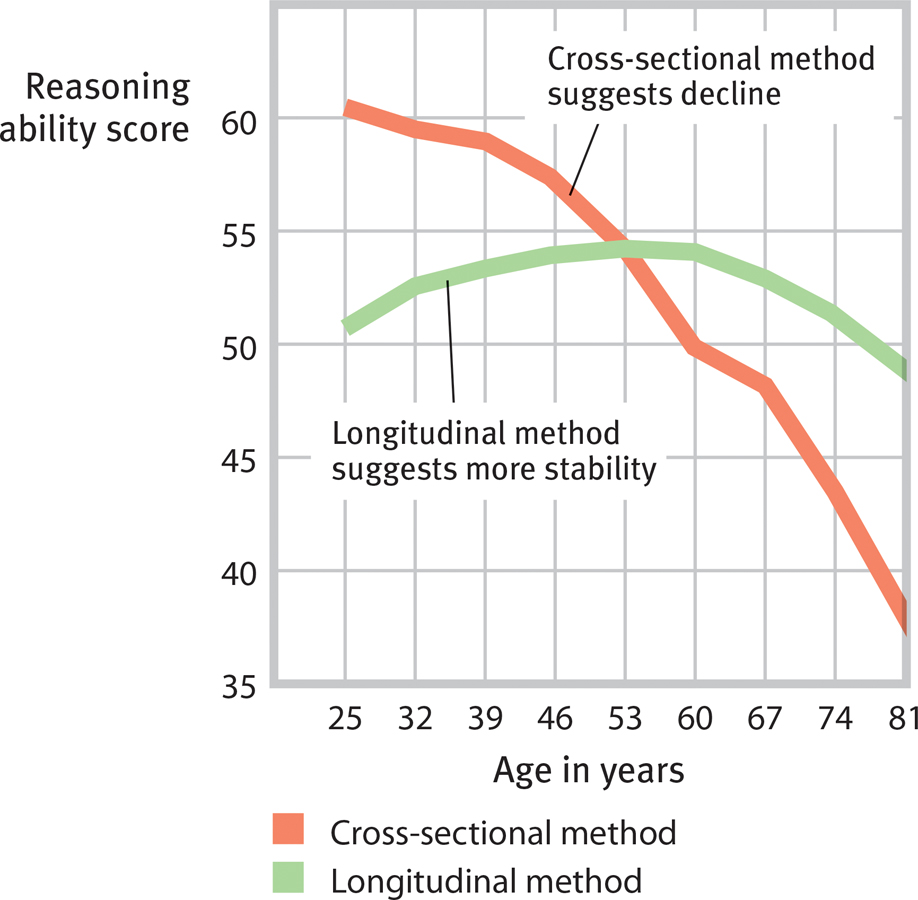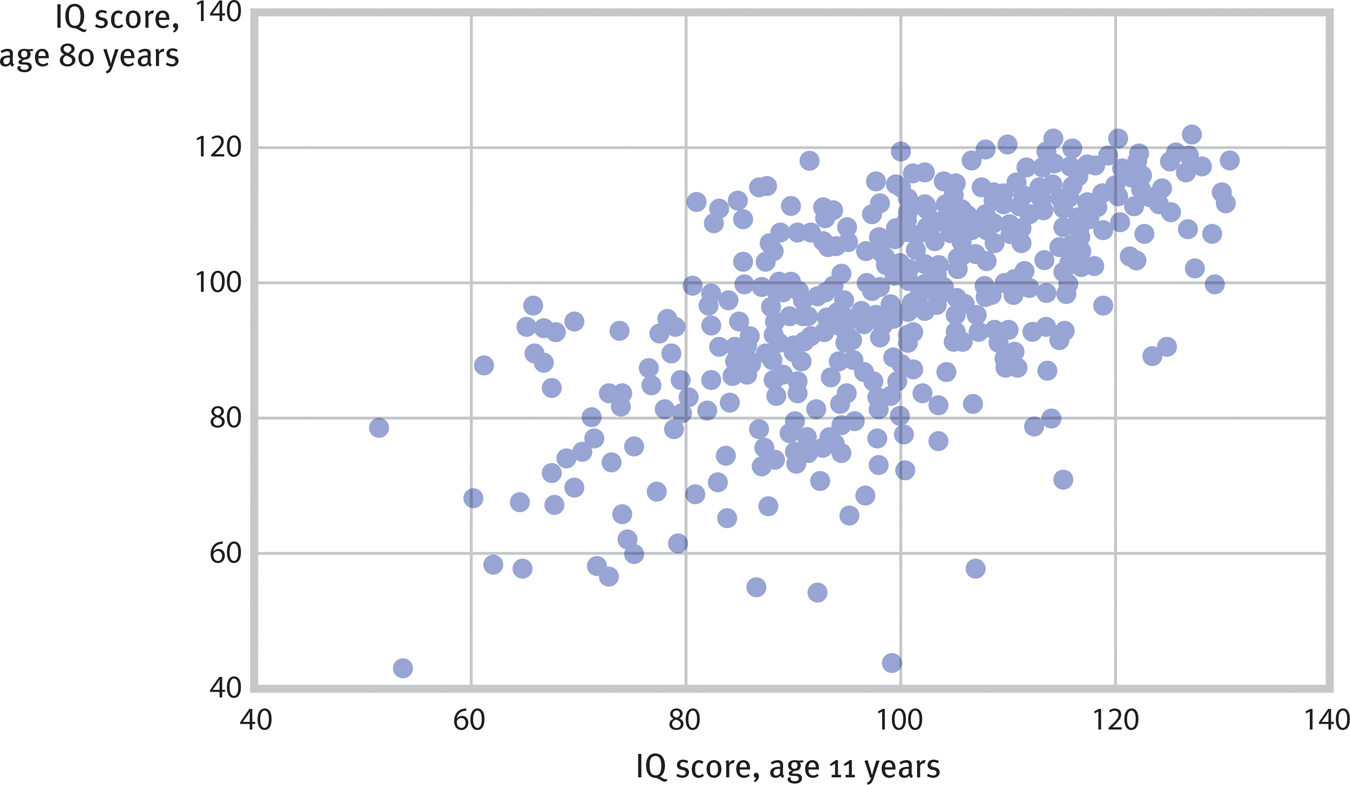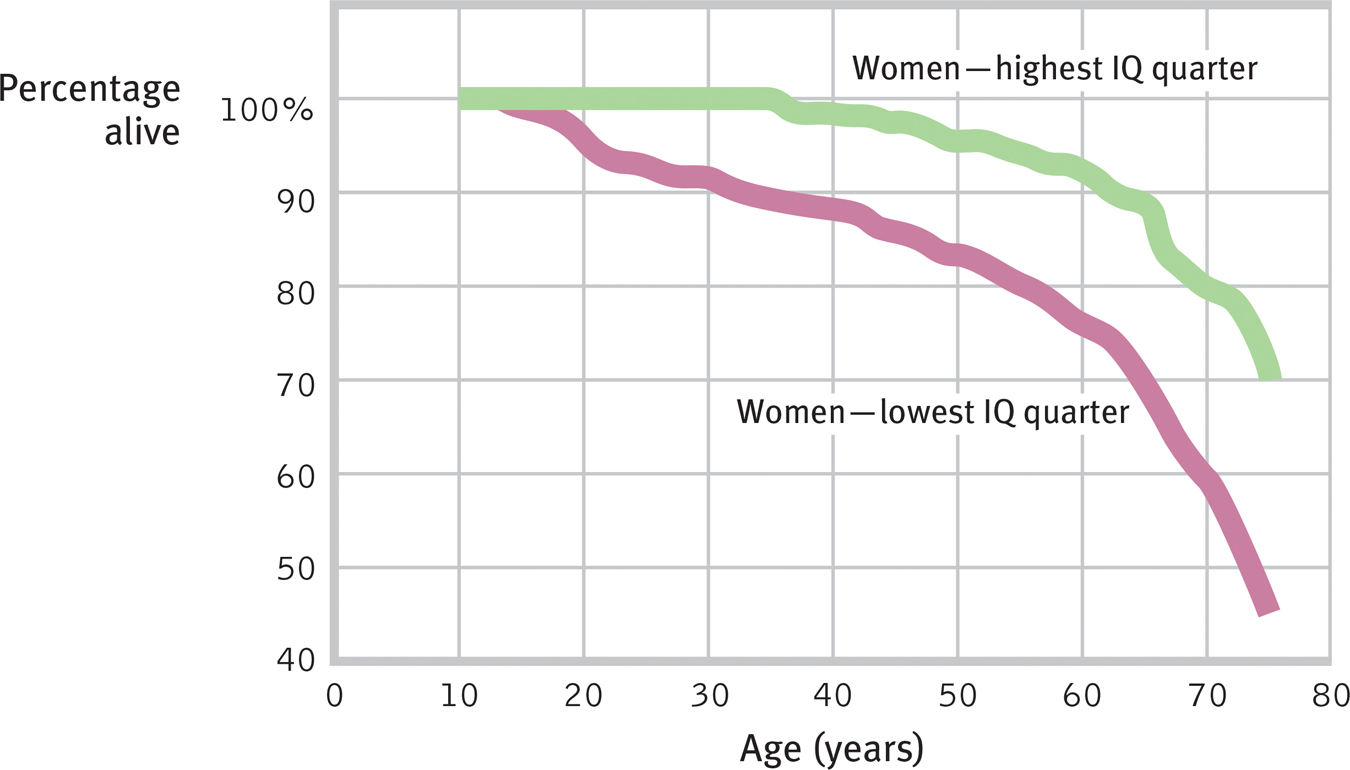Aging and Intelligence
What happens to our intellectual muscles as we age? Do they gradually decline, as does our body strength? Or do they remain constant? The quest for answers to these questions illustrates psychology’s self-correcting process. This research developed in phases.
Phase I: Cross-Sectional Evidence for Intellectual DeclineIn cross-sectional studies, researchers at one point in time test and compare people of different ages. In such studies, older adults give fewer correct answers on intelligence tests than do younger adults. WAIS-creator David Wechsler (1972) therefore concluded that “the decline of mental ability with age is part of the general [aging] process of the organism as a whole.”
For a long time, this rather dismal view went unchallenged. Many corporations established mandatory retirement policies, assuming the companies would benefit by replacing aging workers with younger, more capable, employees. As “everyone knows,” you can’t teach an old dog new tricks.
Phase II: Longitudinal Evidence for Intellectual StabilityAfter colleges in the 1920s began giving intelligence tests to entering students, several psychologists saw their chance to study intelligence longitudinally. They retested the same cohort—the same group of people—over a period of years (Schaie & Geiwitz, 1982). What they found was a surprise: Until late in life, intelligence remained stable (FIGURE 31.1). On some tests, it even increased.

 Figure 31.1
Figure 31.1
Cross-sectional versus longitudinal testing of intelligence at various ages In this test of one type of verbal intelligence (inductive reasoning), the cross-sectional method showed declining scores with age. The longitudinal method (in which the same people were retested over a period of years) showed a slight rise in scores well into adulthood. (Data from Schaie, 1994.)
How then are we to account for the cross-sectional findings? In retrospect, researchers saw the problem. When older cross-sectional studies compared 70-year-olds and 30-year-olds, they compared people not only of two different ages but of two different eras. It compared generally less-educated people (born, say, in the early 1900s) with better-educated people (born after 1950), people raised in large families with people raised in smaller families, people growing up in less affluent families with people raised in more affluent families.
With the more optimistic results from longitudinal studies, the myth that intelligence sharply declines with age was laid to rest. Famed painter Anna Mary Robertson Moses (“Grandma Moses”) took up painting in her seventies, and at age 88 a popular magazine named her “Young Woman of the Year.” At age 89, architect Frank Lloyd Wright designed New York City’s Guggenheim Museum. As “everyone knows,” given good health, you’re never too old to learn.
Phase III: It All DependsWith “everyone knowing” two different and opposing facts about age and intelligence, something was wrong. As it turns out, longitudinal studies have their own pitfalls. Those who survive to the end of such studies may be bright, healthy people whose intelligence is least likely to decline. (Perhaps people who died younger and were removed from the study had declining intelligence.) Adjusting for the loss of participants, as did a study following more than 2000 people over age 75 in Cambridge, England, revealed a steeper intelligence decline, especially after 85 (Brayne et al., 1999).
Research is further complicated by the finding that intelligence is not a single trait, but rather several distinct abilities. Intelligence tests that assess speed of thinking may place older adults at a disadvantage because of their slower neural processing. Meeting old friends on the street, names rise to the mind’s surface more slowly—”like air bubbles in molasses,” said David Lykken (1999). But slower processing need not mean less intelligence. In four studies in which players were given 15 minutes to complete New York Times crossword puzzles, the highest average performance was achieved by adults in their fifties, sixties, and seventies (Salthouse, 2004). “Wisdom” tests—which assess “expert knowledge about life in general and good judgment and advice about how to conduct oneself in the face of complex, uncertain circumstances”—also suggested that older adults more than hold their own (Baltes et al., 1993, 1994, 1999).
“Knowledge is knowing a tomato is a fruit; wisdom is not putting it in a fruit salad.”
So the answers to our age-and-intelligence questions depend on what we assess and how we assess it. Crystallized intelligence—our accumulated knowledge as reflected in vocabulary and analogies tests—increases up to old age. Fluid intelligence—our ability to reason speedily and abstractly, as when solving novel logic problems—decreases beginning in the twenties and thirties, slowly up to age 75 or so, then more rapidly, especially after age 85 (Cattell, 1963; Horn, 1982; Salthouse, 2009, 2013). With age we lose and we win. We lose recall memory and processing speed, but we gain vocabulary knowledge (FIGURE 31.2). Our decisions also become less distorted by negative emotions such as anxiety, depression, and anger (Blanchard-Fields, 2007; Carstensen & Mikels, 2005). And despite their lesser fluid intelligence, older people also display greater wisdom in seeing multiple perspectives, allowing for compromise, and recognizing the limits of what they know (Grossman et al., 2010, 2012).

 Figure 31.2
Figure 31.2
With age, we lose and we win. Studies reveal that word power grows with age, while fluid intelligence dimensions decline. (Data from Salthouse, 2010.)
Age-related cognitive differences help explain why older adults are less likely to embrace new technologies (Charness & Boot, 2009). These cognitive differences also help explain why mathematicians and scientists produce much of their most creative work during their thirties, when fluid intelligence is at its peak (Jones et al., 2014). In contrast, authors, historians, and philosophers tend to produce their best work in their forties, fifties, and beyond—after accumulating more knowledge (Simonton, 1988, 1990). Poets, for example, who depend on fluid intelligence, reach their peak output earlier than prose authors, who need the deeper knowledge reservoir that accumulates with age. This finding holds in every major literary tradition, for both living and dead languages.
“In youth we learn, in age we understand.”
Marie Von Ebner-Eschenbach, Aphorisms, 1883
RETRIEVAL PRACTICE
- Researcher A is well-funded to learn about how intelligence changes over the life span. Researcher B wants to study the intelligence of people who are now at various life stages. Which researcher should use the cross-sectional method, and which the longitudinal method?
Researcher A should develop a longitudinal study to examine how intelligence changes in the same people over the life span. Researcher B should develop a cross-sectional study to examine the intelligence of people now at various life stages.
Stability Over the Life Span
Now what about the stability of intelligence scores early in life? Infants’ and toddlers’ attention, processing speed, and learning give some clue to their intelligence score in later childhood and early adulthood (Fagan, 2011; Rose et al., 2012). For extremely impaired or very precocious children, those early indications can be very predictive. Yet for most children, casual observation and intelligence tests before age 3 only modestly predict their future aptitudes (Humphreys & Davey, 1988; Tasbihsazan et al., 2003). Even Albert Einstein was once thought “slow”—as he was in learning to talk (Quasha, 1980).
“My dear Adele, I am 4 years old and I can read any English book. I can say all the Latin substantives and adjectives and active verbs besides 52 lines of Latin poetry.”
Francis Galton, letter to his sister, 1827
By age 4, however, children’s performance on intelligence tests begins to predict their adolescent and adult scores. The consistency of scores over time increases with the age of the child. The remarkable stability of aptitude scores by late adolescence is seen in a U.S. Educational Testing Service study of 23,000 students who took the SAT and then later took the GRE (Angoff, 1988). On either test, verbal scores correlated only modestly with math scores—revealing that these two aptitudes are distinct. Yet scores on the SAT verbal test correlated +.86 with the scores on the GRE verbal tests taken four to five years later. An equally astonishing +.86 correlation occurred between the two math tests. Given the time lapse and differing educational experiences of these 23,000 students, the stability of their aptitude scores is remarkable.
Ironically, SAT and GRE scores have correlated better with each other than either has with its intended criterion, school achievement. Thus, their reliability has far exceeded their predictive validity. If either test was much affected by coaching, luck, or how one feels on the test day (as so many people believe), such reliability would be impossible.
Ian Deary and his colleagues (2004, 2009, 2013) set the record for long-term follow-up. Their amazing longitudinal studies have been enabled by their country, Scotland, doing something that no nation has done before or since. On June 1, 1932, essentially every child in the country born in 1921—87,498 children around age 11—took an intelligence test. The aim was to identify working-class children who would benefit from further education. Sixty-five years later to the day, Patricia Whalley, the wife of Deary’s co-worker, Lawrence Whalley, discovered the test results on dusty storeroom shelves at the Scottish Council for Research in Education, not far from Deary’s Edinburgh University office. “This will change our lives,” Deary replied when Whalley told him the news.
And so it has, with dozens of studies of the stability and the predictive capacity of these early test results. For example, when the intelligence test administered to 11-year-old Scots in 1932 was readministered to 542 survivors as turn-of-the-millennium 80-year-olds, the correlation between the two sets of scores—after nearly 70 years of varied life experiences—was striking (FIGURE 31.3). Ditto when 106 survivors were retested at age 90 (Deary et al., 2013). Another study that followed Scots born in 1936 from ages 11 to 70 confirmed the remarkable stability of intelligence, independent of life circumstance (Johnson et al., 2010).

 Figure 31.3
Figure 31.3
Intelligence endures When Ian Deary and his colleagues (2004) retested 80-year-old Scots, using an intelligence test they had taken as 11-year-olds, their scores across seven decades correlated +.66, as shown here. (Data from Deary et al., 2004.) When 106 survivors were again retested at age 90, the correlation with their age 11 scores was +.54 (Deary et al., 2013).
“Whether you live to collect your old-age pension depends in part on your IQ at age 11.”
lan Deary, “Intelligence, Health, and Death,” 2005
High-scoring 11-year-olds also were more likely to be living independently as 77-year-olds and were less likely to have suffered Alzheimer’s disease (Starr et al., 2000; Whalley et al., 2000). Among girls scoring in the highest 25 percent, 70 percent were still alive at age 76—as were only 45 percent of those scoring in the lowest 25 percent (FIGURE 31.4). (World War II prematurely ended the lives of many of the male test-takers.) Follow-up studies with other large samples confirm the phenomenon: More intelligent children and adults live healthier and longer (Calvin et al., 2011; Deary et al., 2008, 2010; Johnson et al., 2011). One study that followed 93 nuns found that those exhibiting less verbal ability in essays written when entering convents in their teens were more at risk for Alzheimer’s disease after age 75 (Snowdon et al., 1996).

 Figure 31.4
Figure 31.4
Living smart Women scoring in the highest 25 percent on the Scottish national intelligence test at age 11 tended to live longer than those who scored in the lowest 25 percent. (Data from Whalley & Deary, 2001.)

Explore how researchers have studied these issues with LaunchPad’s How Would You Know If Intelligence Changes With Age?
Pause a moment: Have you any idea why more intelligent people might live longer? Deary (2008) reports four possible explanations:
- Intelligence facilitates more education, better jobs, and a healthier environment.
- Intelligence encourages healthy living: less smoking, better diet, more exercise.
- Prenatal events or early childhood illnesses might have influenced both intelligence and health.
- A “well-wired body,” as evidenced by fast reaction speeds, perhaps fosters both intelligence and longevity.

 Figure 31.1
Figure 31.1
 Figure 31.2
Figure 31.2
 Figure 31.3
Figure 31.3
 Figure 31.4
Figure 31.4